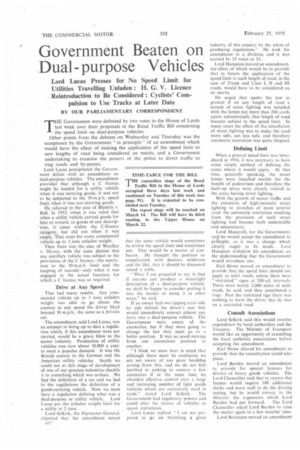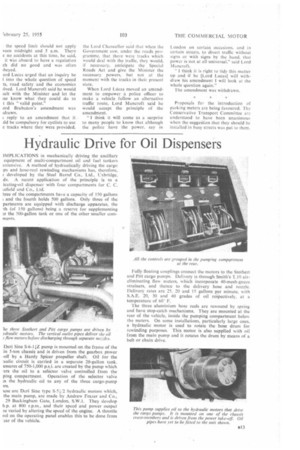Government Beaten on Dual purpose Vehicles
Page 38

Page 39

If you've noticed an error in this article please click here to report it so we can fix it.
Lord Lucas Presses for No Speed Limit for Utilities Travelling Unladen : H. G. V. Licence • Reintroduction to Be Considered : Cyclists' Compulsion to Use Tracks at Later Date
BY OUR PARLIAMENTARY CORRESPONDENT
THE Government were defeated by two votes in the House of Lords last week over their proposals in the Road Traffic Bill concerning the speed limit on dual-purpose vehicles. Other points from the debates on Wednesday and Thursday was the
acceptance by the Government "in principle" of an amendment which would have the effect of making the application of the speed limit to new lengths of road being considered on merits, and a Government undertaking to examine the powers of the police to direct traffic to ring roads and by-passes.
Lord Lucas precipitated the Govern ment defeat with an amendment on dual-purpose vehicles. The amendment provided that although a C licence might he needed for a utility vehicle when it was carrying goods, it was mit to be Subjected to the 30-m.p.h. speed limit vvheis it was not carrying goods.
He referred to the case of Blenkin,v. Bell, in 1952, When it was ruled that when a utility vehicle carried goods. for hire or reward, or goods of any description, it came within the C-licence category, but did not when it was empty. That went for every commercial vehicle up to 3.tons unladen weight.
Then there was the case of Woolley v. Moore, with the same dictum that any ancillary vehicle was subject to the provisions of the C licence—the restriction to the 30-mph. limit and the keeping of records—only when it was engaged in the actual function for which a C licence was so required.
Drive at Any Speed
That had many results. Any commercial vehicle up to 3 tons unladen weight was able to go about the country at any speed the driver liked beyond 30 m.p.h., the same as a private car.
The amendment, said Lord Lucas, was an attempt to bring up to date a regulation which, if this amendment were not carried, would be a grave blow to the motor industry. Production of utility vehicles was now about 30,000 a year, to meet a popular demand. It was the British answer to the German and the . American utility vehicles. Surely we could not at this stage of development of one of our greatest industries shackle it to something which was archaic. We had the definition of a car and we had in the regulations the definition of a goods-carrying vehicle. Now we must have a regulation defining what was a
dual-purpose or utility vehicle. Lord Lucas put the unladen weight limit for a utility at 2 tons.
Lord Selkirk, the Paymaster-General, objected that the amendment meant BP
that the same vehicle would sometimes be within the speed limit and sometimes not. That would be a matter of confusion. He thought" the position so complicated, with doctors, midwives and the like, that it should be discussed round a table.
What I am prepared to say is that if anyone can produce a watertight description of a dual-purpose vehicle, we shall be happy to consider putting it into the statute or using it in other ways," he said.
If an owner had two tipping scats side by side behind the driver's seat that would immediately convert almost any lorry into a dual-purpose vehicle. The Government were aware of the anomalies, but if they were going to change the law they must go to a better position. It was no good moving from one anomalous position to another.
"1 think we must bear in mind that although there must be confusion we are not aware of any great hardship arising from this, and we do not feel justified in seeking to remove a few anomalies if at the same time we abandon effective control over a large and increasing number of light goods vehicles which are extensively used in trade," stated Lord Selkirk. The Government had regulatory powers and could alter the classes of vehicles or speed restrictions.
Lord Lucas replied: " I am not prepared to go on throttling a great industry of this country by the whim of producing regulations." He took his amendment to a division, and it was carried by 35 votes to 33.
Lord Hampton moved an amendment, the effect of which would be to provide that in future the application of the speed limit to each length of road, in the case of Trunk and Class 1, II and III roads, would have to be considered on its merits.
He urged that under the law at present if on any length of road a system of street lighting was installed with the lamps not more than 200 yards apart, automatically that length of road became subject to the speed limit. In many eases the effect of the. installation of street lighting was to make the road more safe, not less safe, and therefore automatic restriction was quite illogical.
Defming Limit When a general speed limit was introduced in 1934, it was necessary to have some simple method of defining the areas where it would apply. At that time, generally speaking, the street lamps were installed mainly for the benefit of pedestrians and therefore the built-up areas were closely related to the areas having street lighting.
With the growth of motor traffic and the extension of high-intensity street lighting to stretches of main arterial road, the automatic restriction resulting from the • provision of such street lighting had become both undesirable and unnecessary.
Lord Mancroft, for the Government, said he would accept the amendment in principle, as. it was a change which clearly ought to be made. Lord Hampton withdrew his amendment on the understanding that the Government would introduce one.
Earl klowe moved an amendment to provide that the speed limit should not apply to unlit roads, unless there were " restricted' signs at 200-yd. intervals. There were nearly 2,000 miles of unlit roads, he said, and they constituted a trap. Past the restricted sign there was nothing to warn the driver that he was on a restricted road.
Consult Associations
Lord Selkirk said this would involve expenditure by local authorities and the Treasury. The Minister of Transport would like an opportunity of consulting the local authority associations before accepting the amendment.
Earl Howe altered his amendment to provide that the consultation could take place.
Lord Burden moved an amendment to provide for special licences for drivers of heavy goods vehicles. The Lord Chancellor said that to testore this licence would require 100 additional clerks and more staff to do the driving testing, but he would convey to the Minister the arguments which Lord Burden had put forward. The Lord Chancellor asked Lord Burden to raise the matter again in a few months' time.
Lord Bra bazon moved an amendment the speed limit should not apply n en midnight and 5 a.m. There e no accidents at this time, he said, it was absurd to have a regulation ch did no good and was often beyed.
ord Lucas urged that an inquiry be I into the whole question of speed ts, road safety and the economics tIved. Lord Mancroft said he would ;ult with the Minister and let the Ise know what they could do to t this "valid point."
ord Brabazon's amendment was tdrawn.
reply to an amendment that it ild be compulsory for cyclists to use e tracks where they were provided, the Lord Chancellor said that when the Government saw, under the roads programme. that there were tracks which would deal with the traffic, they would, if necessary, anticipate the Special Roads Act and give the Minister the necessary powers, but not at the moment with the tracks in their present state.
When Lord Lucas moved an amendment to empower a police officer to make a vehicle follow an alternative traffic route, Lord Mancroft said he would accept the principle of the amendment.
"1 think it will come as a surprise to many people to know that although the police have the power, say in
London on certain occasions, and in certain streets, to divert traffic without signs or with signs by the hand, that power is not at all universal," said Lord Mancroft.
"1 think it is right to tidy this matter up and if he (Lord Lucas] will withdraw his amendment I will look at the whole question again."
The amendment was withdrawn.
Proposals for the introduction of parking meters are being favoured. The Conservative Transport Committee are understood to have been unanimous when the suggestion that they should be installed in busy streets was put to them.




















































































